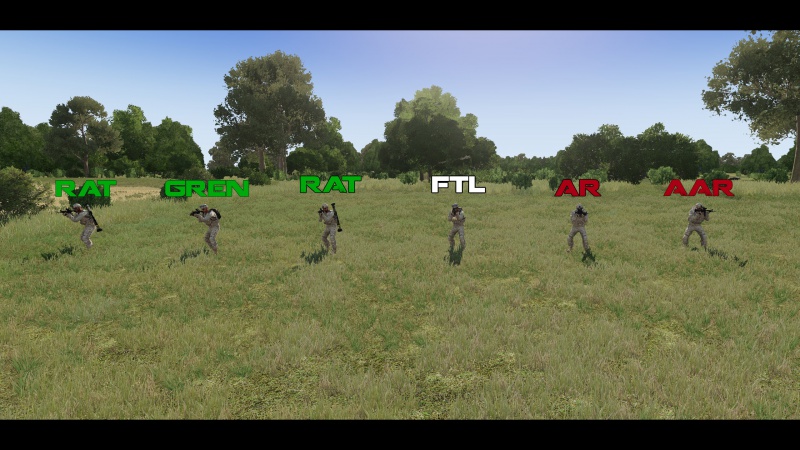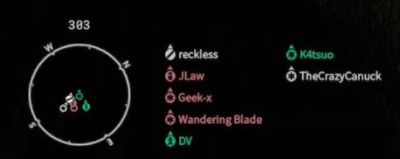Difference between revisions of "New Infantry Guide"
Views
Actions
Namespaces
Variants
Tools
(→Platoon Structure: added: "During regular sessions, the "Section" is replaced with "Squad"." to help mitigate any potential confusion when looking at the wiki before session compared to a campaign mission.) |
m (→Medical: Updated to remove old A3 lingo. Will need a screenshot of new injuries from reforger.) |
||
| (2 intermediate revisions by one other user not shown) | |||
| Line 7: | Line 7: | ||
==Platoon Structure== | ==Platoon Structure== | ||
<center>[[File:Battalion Structure white2.png|center|thumb|700x700px|Regardless of mission and/or objectives, Coalition always uses the same platoon structure during campaigns to ensure players have an understandable and systematic experience that promotes organization. During regular sessions, the "Section" is replaced with "Squad".]]<br \> | <center>[[File:Battalion Structure white2.png|center|thumb|700x700px|Regardless of mission and/or objectives, Coalition always uses the same platoon structure during campaigns to ensure players have an understandable and systematic experience that promotes organization. During regular sessions, the "Section" is replaced with "Squad". Throughout this guide, Section Leader or SL is the same as a Squad Leader during regular session.]]<br \> | ||
<u>'''DESIGN AND IMPLEMENTATION'''</u></center> | <u>'''DESIGN AND IMPLEMENTATION'''</u></center> | ||
| Line 29: | Line 29: | ||
:::Binoculars | :::Binoculars | ||
:::Short-range AN/PRC-343 Radio | :::Short-range AN/PRC-343 Radio | ||
'''AR - Automatic Rifleman''' | '''AR - Automatic Rifleman''' | ||
The AR is the second in command and in charge of the first color team. If you're an AAR, stay with him. | |||
::<u>'''Loadout''':</u> | ::<u>'''Loadout''':</u> | ||
:::Automatic Rifle or LMG | :::Automatic Rifle or LMG | ||
| Line 39: | Line 39: | ||
'''AAR - Assistant Automatic Rifleman''' | '''AAR - Assistant Automatic Rifleman''' | ||
The AAR's job is to spot for the AR, adjust his fire, and ensure he maintains a healthy amount of ammunition when possible. | |||
::<u>'''Loadout''':</u> | ::<u>'''Loadout''':</u> | ||
:::Rifle or Carbine | :::Rifle or Carbine | ||
| Line 46: | Line 47: | ||
'''GREN - Grenadier''' | '''GREN - Grenadier''' | ||
The GREN's job is to serve as a maneuver rifleman with the added ability to lay extra indirect fire on to enemy positions. He is the second color team leader. | |||
::<u>'''Loadout''':</u> | ::<u>'''Loadout''':</u> | ||
:::Rifle with M203/M320 or GP25 GL | :::Rifle with M203/M320 or GP25 GL | ||
| Line 53: | Line 55: | ||
'''RAT - Rifleman Anti-tank''' | '''RAT - Rifleman Anti-tank''' | ||
The RAT's job is to serve as a generally room-clearing or maneuver rifleman as well as destroy any armored assets the fire team may encounter. Stay near your GREN when possible. | |||
::<u>'''Loadout''':</u> | ::<u>'''Loadout''':</u> | ||
:::Rifle or Carbine | :::Rifle or Carbine | ||
| Line 68: | Line 71: | ||
Red team serves as a base-of-fire (BOF) team with the FTL, AR, and AAR. The combination of an underbarrelled grenade launcher, light machine gun (LMG), and two sets of binoculars enables red team to provide command and cover to green team in a multitude of environments. <br \> | Red team serves as a base-of-fire (BOF) team with the FTL, AR, and AAR. The combination of an underbarrelled grenade launcher, light machine gun (LMG), and two sets of binoculars enables red team to provide command and cover to green team in a multitude of environments. <br \> | ||
Green team serves as a maneuver element within the fire team. Their job is to clear buildings, flank if pinned, and generally destroy any vehicle threats that may happen upon the fire team. <br \> | Green team serves as a maneuver element within the fire team. Their job is to clear buildings, flank if pinned, and generally destroy any vehicle threats that may happen upon the fire team or squad. <br \> | ||
A competent section leader will combine all teams efficiently to ensure they work together across multiple types of terrain. | A competent section leader will combine all teams efficiently to ensure they work together across multiple types of terrain. | ||
| Line 74: | Line 77: | ||
===Role Limitations=== | ===Role Limitations=== | ||
While as a recruit during your first couple weeks in the community, you will not be able to take the Fireteam Leader (FTL) or Automatic Rifleman (AR) roles so that you can learn how to be a fireteam member before leading one. | While as a recruit during your first couple weeks in the community, you will not be able to take the Fireteam Leader (FTL) or Automatic Rifleman (AR) roles so that you can learn how to be a fireteam member before leading one. | ||
==Formations & Spacing== | ==Formations & Spacing== | ||
| Line 83: | Line 85: | ||
''click for larger picture'' | ''click for larger picture'' | ||
By default, we use the wedge as a movement-to-contact formation. This formation allows for the maximum firepower forward and to <br \>the rear if need-be, but suffers from a large cross-section from the sides. | By default, we use the wedge as a movement-to-contact formation. This formation allows for the maximum firepower forward and to <br \>the rear if need-be, but suffers from a large cross-section from the sides. | ||
<u>'''THE LINE'''</u><br \> | <u>'''THE LINE'''</u><br \> | ||
| Line 114: | Line 116: | ||
====Section Nets ==== | ====Section Nets ==== | ||
Not used as often, but can occur in certain missions. The entire Section will be on a single AN/PRC-343 channel (Alpha on Channel 1, Bravo on Channel 2, etc). | Not used as often, but can occur in certain missions. The entire Section will be on a single AN/PRC-343 channel (Alpha on Channel 1, Bravo on Channel 2, etc). SLs will still retain a long-range radio for communicating with other sections and the platoon leader. | ||
Minimizing radio chatter becomes very important, as many more people will be using a single net, and the channel may quickly become clogged with radio traffic. Clarifying the identity of yourself when transmitting the bearing for a callout is also important as fireteams may be located far from each other. | Minimizing radio chatter becomes very important, as many more people will be using a single net, and the channel may quickly become clogged with radio traffic. Clarifying the identity of yourself when transmitting the bearing for a callout is also important as fireteams may be located far from each other. | ||
| Line 128: | Line 130: | ||
For a more in-depth writeup of medical [[Medical Information|click here]]. | For a more in-depth writeup of medical [[Medical Information|click here]]. | ||
The following image shows the method for '''Basic Medical Treatment''':[[File:Basic Medical Treatment.png|frameless|566x566px]] | |||
[[File: | The following shows the method behind '''healing wounds with a medial kit''':[[File:HEALWOUNDS.png|frameless|434x434px]] | ||
===Self-aid=== | |||
If injured in the field, Open your inventory to quickly see your injuries. You can hover over each injury to see its status, and quickly determine how to treat it. You will have Access to 2 bandages, 2 tourniquets, and a stick of morphine. | |||
'''If you are in pain, have lost a substantial amount of blood, or are out of supplies. Inform your leadership that you require a medic ASAP.''' Failure to do so can result in you going unconscious and being killed by cardiac arrest. | |||
Otherwise once your bleeding has stopped, you have fluids in you, and all tourniquets are removed, it is safe to continue fighting. | Otherwise once your bleeding has stopped, you have fluids in you, and all tourniquets are removed, it is safe to continue fighting. | ||
| Line 154: | Line 155: | ||
==Playing AAR== | ==Playing AAR== | ||
The AAR is the second man behind the LMG. His task is to support the Automatic Rifleman in the employment of his gun and protect him during its employment. While moving, you should stick directly with your color team | The AAR is the second man behind the LMG. His task is to support the Automatic Rifleman in the employment of his gun and protect him during its employment. While moving, you should stick directly with your color team members - who are the AR and FTL - at all times. | ||
:Your tasks include: | :Your tasks include: | ||
| Line 163: | Line 164: | ||
==Playing RAT== | ==Playing RAT== | ||
The Rifleman (Anti-Tank) is our primary means of defense against enemy armored vehicles. You are the sections, and often the whole platoons only anti-tank asset. Thus, your armament and your proficiency with it can make the difference between your whole team dying - or not. While moving, stay with the second color team | The Rifleman (Anti-Tank) is our primary means of defense against enemy armored vehicles. You are the sections, and often the whole platoons, only anti-tank asset. Thus, your armament and your proficiency with it can make the difference between your whole team dying - or not. While moving, stay with the second color team members - the Grenadier and FTL - at all times. | ||
: Your tasks include: | : Your tasks include: | ||
| Line 172: | Line 173: | ||
== Playing GREN== | == Playing GREN== | ||
The Grenadiers weapon is the grenade launcher, most commonly fixed under the barrel. With it, he can use both HE grenades to fight enemies behind cover, in ditches or in windows and smoke grenades to conceal his teams movement. | The Grenadiers weapon is the grenade launcher, most commonly fixed under the barrel. With it, he can use both HE grenades to fight enemies behind cover, in ditches or in windows, and smoke grenades to conceal his teams movement or obscure the vision of the enemy. | ||
:Your tasks include: | :Your tasks include: | ||
Latest revision as of 18:47, 12 June 2024
Welcome to the new infantryman's guide to surviving the coalition session. The purpose of this guide is to introduce you to how the community of Coalition conducts warfare and what you need to know before the bullets start flying, rather than what the US military does in the real world. While our tactics, techniques, and procedures sometimes match and greatly pull from our real-world counterparts, it would be silly to teach you real-world tactics for a virtual environment like some "super-milsim" group.
With that in mind, take this guide seriously as you'll be expected to know and perform techniques written here in real time during sessions.
The Basics
Platoon Structure

DESIGN AND IMPLEMENTATION
Each section consists of two fireteams. Each section consists of at least six troopers:
SL - Section Leader
MEDIC - Medical Officer
FTL - Fireteam Leader
AR - Automatic Rifleman (Second in command)
AAR - Assistant Automatic Rifleman
GREN - Grenadier
RAT - Rifleman Anti-tank
Fireteam Structure & Roles
There are five roles in each fire team that you must know:
FTL - Fireteam Leader
This man is your direct line leader. All orders will stem from him. Always stay tactically near him.
- Loadout:
- Rifle with M203/M320 or GP25 GL
- Binoculars
- Short-range AN/PRC-343 Radio
- Loadout:
AR - Automatic Rifleman
The AR is the second in command and in charge of the first color team. If you're an AAR, stay with him.
- Loadout:
- Automatic Rifle or LMG
- Pistol
- Short-range radio (Squad Net)
- Loadout:
AAR - Assistant Automatic Rifleman
The AAR's job is to spot for the AR, adjust his fire, and ensure he maintains a healthy amount of ammunition when possible.
- Loadout:
- Rifle or Carbine
- Binoculars
- Short-range radio (Squad Net)
- Loadout:
GREN - Grenadier
The GREN's job is to serve as a maneuver rifleman with the added ability to lay extra indirect fire on to enemy positions. He is the second color team leader.
- Loadout:
- Rifle with M203/M320 or GP25 GL
- Extra grenades
- Short-range radio (Squad Net)
- Loadout:
RAT - Rifleman Anti-tank
The RAT's job is to serve as a generally room-clearing or maneuver rifleman as well as destroy any armored assets the fire team may encounter. Stay near your GREN when possible.
- Loadout:
- Rifle or Carbine
- Single-use anti-tank launcher
- Short-range radio (Squad Net)
- Loadout:
A Coalition section is broken down into three color teams, each with their own purpose:
WHITE TEAM - SL, MEDIC
RED TEAM - FTL, AR, AAR
GREEN TEAM - FTL, GREN, RAT
Red team serves as a base-of-fire (BOF) team with the FTL, AR, and AAR. The combination of an underbarrelled grenade launcher, light machine gun (LMG), and two sets of binoculars enables red team to provide command and cover to green team in a multitude of environments.
Green team serves as a maneuver element within the fire team. Their job is to clear buildings, flank if pinned, and generally destroy any vehicle threats that may happen upon the fire team or squad.
A competent section leader will combine all teams efficiently to ensure they work together across multiple types of terrain.
Role Limitations
While as a recruit during your first couple weeks in the community, you will not be able to take the Fireteam Leader (FTL) or Automatic Rifleman (AR) roles so that you can learn how to be a fireteam member before leading one.
Formations & Spacing
There are a total of three formations you need to know:
By default, we use the wedge as a movement-to-contact formation. This formation allows for the maximum firepower forward and to
the rear if need-be, but suffers from a large cross-section from the sides.
THE LINE

click for larger picture
Not to be confused with the column, the line is commonly used as a reaction to contact from the wedge to get maximum fire power
forward. It is also used in forests or dense terrain.
THE COLUMN

click for larger picture
The column is used when traversing dangerous obstacles like minefields or when visual signature needs to be as low as possible.
Has great fire support to the flanks, but lacks in the rear and forward. Notice red team is in the rear in order to provide
maximum support.
Each formation consists of a minimum of 5 meters of spacing as displayed in the pictures above.
Your team leader will always instruct you to "push out" or "pull in" while moving in formation and you can utilize your CSI compass to help control spacing.
Radios
For radios, we utilize the in-game radio functions for all of our inter-section communications. This uses push-to-talk or voice activity to speak on a local or radio level (or both), allowing for 3D communication without any third-party tools. Each section is assigned a radio frequency at mission start and it's up to the SL and all FTLs to ensure that they have the correct equipment before mission start. For more information on radios, click here.
Fireteam Nets vs Squad Nets
We use two radio structures: Fireteam Nets and Section Nets. This is dependent on mission design.
Fireteam Nets
What we use most often right now. RED Team and GREEN Team both share the section frequency with each other. Each FTL will have a single radio: the short-range AN/PRC-343 for communicating with their own section. The SL himself will have a short-range and a long-range radios to communicate with both their section and the platoon leader on the platoon frequency (either two AN/PRC-148s, or one AN/PRC-148 and one AN/PRC-152. All long-range radios will use the same channel frequencies).
It should be kept in mind that non-leadership personnel will have no direct radio communication with their squad leader. Medical personnel are also not guaranteed to be listening on your short range channel. If you need to contact the squad leader or request medical assistance, do so through your fireteam leader. This also makes recovering the radio from a downed fireteam leader essential, especially as bodies are not persistent.
Section Nets
Not used as often, but can occur in certain missions. The entire Section will be on a single AN/PRC-343 channel (Alpha on Channel 1, Bravo on Channel 2, etc). SLs will still retain a long-range radio for communicating with other sections and the platoon leader.
Minimizing radio chatter becomes very important, as many more people will be using a single net, and the channel may quickly become clogged with radio traffic. Clarifying the identity of yourself when transmitting the bearing for a callout is also important as fireteams may be located far from each other.
Communicating
One of the best things you can do as a new infantryman is learn to communicate with your other section members. Regardless of roles, know when to and when not to speak on the fireteam radio to ensure maximum information flow reaches the right ears. Some guidelines:
- Always state your name when speaking on the radio. Avoid words like "me" and "I".
- Use the "ADD" report when calling contact on the radio - Alert, Direction, Distance
- Example: Green team contact, two EI at that tree line bearing 252, 300 meters
- Stay with your color team at all times. This allows you to simply speak to them.
Medical
For a more in-depth writeup of medical click here.
The following image shows the method for Basic Medical Treatment:
The following shows the method behind healing wounds with a medial kit:
Self-aid
If injured in the field, Open your inventory to quickly see your injuries. You can hover over each injury to see its status, and quickly determine how to treat it. You will have Access to 2 bandages, 2 tourniquets, and a stick of morphine.
If you are in pain, have lost a substantial amount of blood, or are out of supplies. Inform your leadership that you require a medic ASAP. Failure to do so can result in you going unconscious and being killed by cardiac arrest.
Otherwise once your bleeding has stopped, you have fluids in you, and all tourniquets are removed, it is safe to continue fighting.
NOTE: "Stable" means no bleeding/has fluids/has stable heart rate. Just because you're limbs are bandaged does not mean you are stable!
The Advanced
Movement Orders
Occasionally, your team leader may order you to do specific movements that you will need to know.
Bounding
Pictures TBA
Peeling
Pictures TBA
Playing AAR
The AAR is the second man behind the LMG. His task is to support the Automatic Rifleman in the employment of his gun and protect him during its employment. While moving, you should stick directly with your color team members - who are the AR and FTL - at all times.
- Your tasks include:
- Spotting targets and observing bullet impact using the Binoculars
- Carrying spare ammunition for the gun to sustain its fire
- Watching the ARs flanks while he employs the gun due to his natural inclination to tunnel vision
Playing RAT
The Rifleman (Anti-Tank) is our primary means of defense against enemy armored vehicles. You are the sections, and often the whole platoons, only anti-tank asset. Thus, your armament and your proficiency with it can make the difference between your whole team dying - or not. While moving, stay with the second color team members - the Grenadier and FTL - at all times.
- Your tasks include:
- Range estimation to target
- Correct handling of our common launchers, manuals for which can be found here.
- Patience to ensure a hit
Playing GREN
The Grenadiers weapon is the grenade launcher, most commonly fixed under the barrel. With it, he can use both HE grenades to fight enemies behind cover, in ditches or in windows, and smoke grenades to conceal his teams movement or obscure the vision of the enemy.
- Your tasks include:
- Range estimation to target
- Employing the HE grenades with precision
- Knowing when and how to employ smoke
- IE: Never smoke your own position unless you are retreating. Smoke the enemies position or the path to the enemies position instead. Avoid placing smokes in a way that you have to run through your own smoke.

